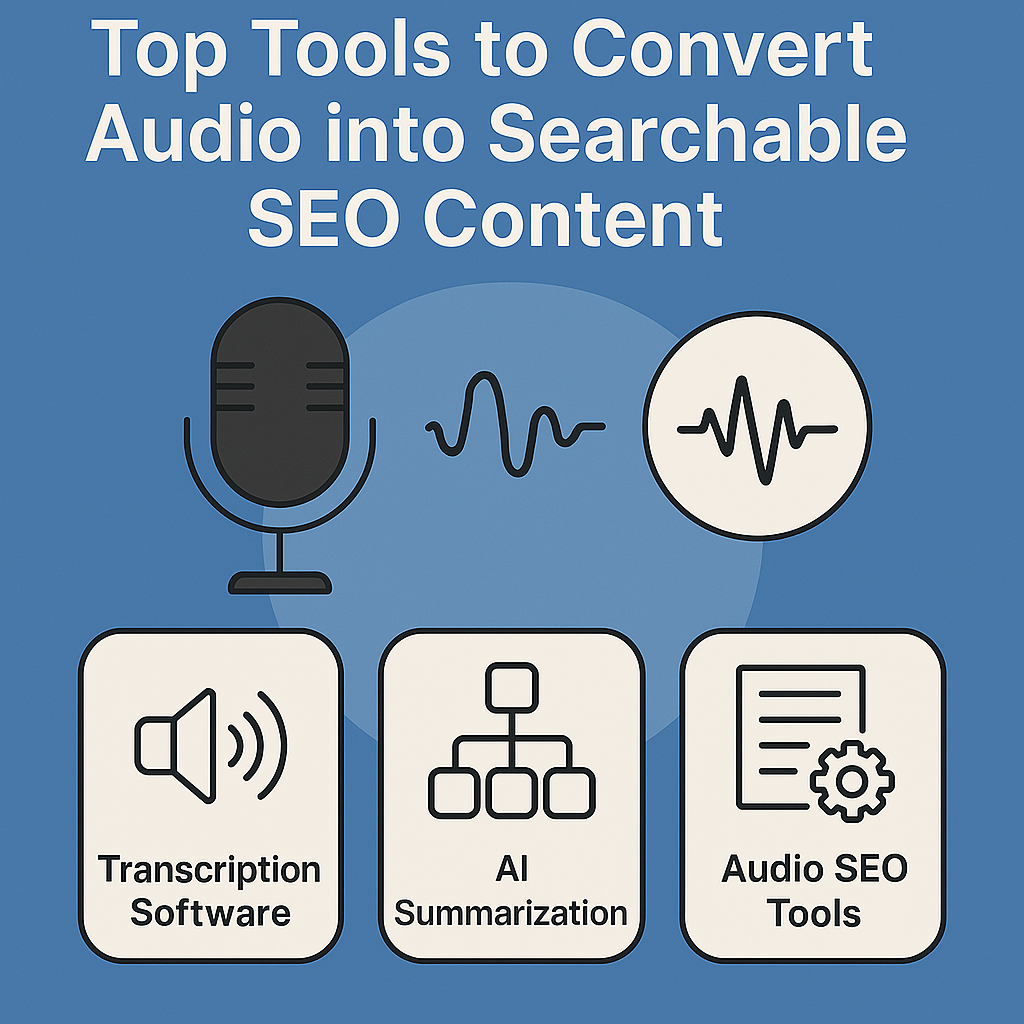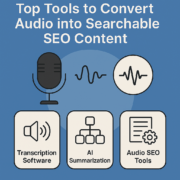Top Tools to Convert Audio into Searchable SEO Content
Most SEO teams are sitting on a stockpile of untapped content: audio. Podcasts, webinars, video interviews, internal recordings—they’re packed with insights that rarely get reused. The trick? Turning those spoken words into text that search engines can index and rank.
Let’s break down the best transcription tools that help marketers convert audio into content that drives organic traffic. Whether you’re building out blog posts, video descriptions, or FAQ hubs, these tools can help you go from raw audio to SEO-ready content at scale.
Why Converting Audio to Text Supports SEO Strategy
Converting audio to text helps improve SEO by making content searchable, indexable, and keyword-rich. When transcripts are published alongside audio or video, search engines can crawl the text, allowing your content to rank for relevant queries.
Audio content often includes long-tail keywords, questions, and topic clusters that naturally support SEO goals. Transcribing podcasts, webinars, or interviews also gives marketers more opportunities to repurpose content into blog posts, summaries, or FAQ sections that attract organic traffic.
Key Features to Look For in Audio-to-Text Tools
What features should you prioritize in an audio-to-text transcription tool? The answer depends on your content workflow, but for SEO-focused marketers, there are a few non-negotiables. The right tool should save time, improve accuracy, and support content repurposing at scale.
Look for these features:
- High transcription accuracy — Avoid tools that struggle with accents, background noise, or technical vocabulary.
- Speaker identification — Helps structure transcripts clearly, especially for interviews or panel discussions.
- Multi-language support — Essential for global SEO strategies and local content campaigns.
- Searchable and editable interface — Allows you to refine transcripts before publishing.
- Integration with your content workflow — Check for compatibility with CMS, podcast platforms, or AI writing tools.
- Export options — You’ll want formats like TXT, SRT, and DOCX depending on how you repurpose the content.
These features make it easier to turn raw audio into optimized content that ranks in search and delivers long-term traffic.
Top Audio Transcription Tools for SEO-Focused Marketers
With dozens of transcription platforms out there, choosing the right one comes down to how well it fits your content strategy. Below, we’ve highlighted tools that go beyond basic voice-to-text conversion. These platforms help SEO teams repurpose, optimize, and scale audio content into valuable written assets.
1. Tomedes Transcription Tool
Tomedes offers an AI-powered transcription tool that supports multilingual audio and provides quick, editable transcripts. It’s designed for content teams looking to convert recorded conversations, interviews, and webinars into clean, structured text.
In addition to automated transcription, Tomedes supports human review and translation services. This makes it useful for SEO teams managing global campaigns that require high accuracy across multiple languages.
2. Otter.ai
Otter.ai is a cloud-based transcription tool known for its real-time transcription features and collaborative functionality. It automatically records and transcribes meetings, interviews, and lectures, providing searchable transcripts within minutes.
The tool is popular among marketing and editorial teams due to its speaker identification, live note-taking, and integration with platforms like Zoom and Google Meet. For SEO professionals, Otter.ai can help turn spontaneous discussions or recordings into usable, indexable content.
3. Descript
Descript is a transcription and audio editing platform that combines voice-to-text conversion with video and podcast production tools. It’s best known for its Overdub feature, which allows users to edit audio by editing text, much like a document.
For SEO teams, Descript offers a streamlined way to turn audio files into clean transcripts that can be repurposed for written content. Its built-in collaboration features and media editing capabilities also make it a strong option for teams managing multimedia SEO strategies.
4. Trint
Trint is a transcription software designed for teams that need searchable, editable transcripts with quick turnaround. It offers automated transcription supported by AI and features like speaker labeling, timestamping, and collaboration tools.
The platform includes an interactive editor that lets users clean up transcripts, add notes, and export content in various formats. For SEO-focused workflows, Trint is particularly useful for teams that repurpose interviews and meetings into content at scale.
5. Rev
Rev is a transcription service offering both AI-generated and human-transcribed text. It’s best known for its fast turnaround and high accuracy, particularly in industries that require clean, polished transcripts.
Users can upload audio or video files and receive transcripts in formats suited for SEO repurposing. For teams handling sensitive topics or client-facing material, Rev’s human transcription service offers an added layer of precision over automated tools.
How to Turn Transcripts Into Optimized SEO Assets
Once you’ve transcribed your audio, the next step is knowing how to use it effectively. A clean transcript is just the starting point—what you do with it determines its value for SEO. From keyword targeting to content formatting and multilingual optimization, here’s how to turn transcripts into assets that drive traffic.
Use transcripts to target long-tail keywords
Transcripts often include naturally spoken phrases and questions that align closely with long-tail keywords. These terms may not appear in your original content plan but reflect how people actually search.
By reviewing and optimizing your transcripts, you can identify new keyword opportunities, target voice search queries, and improve your chances of ranking for more specific and lower-competition search terms.
Structure transcripts with headers and summaries
Raw transcripts can be dense and difficult to follow. Breaking them up with clear H2 and H3 headers helps improve readability and gives structure to the content.
Summaries and keyword-focused subheadings also make it easier for search engines to understand the context of each section. This improves scannability for users and enhances on-page SEO performance.
Optimize on-page elements
Once your transcript is ready, treat it like any other content asset by applying standard on-page SEO techniques. Start with a clear title and meta description that reflect the topic of the audio.
Use internal linking to connect the transcript to related articles, and apply relevant schema markup such as Article, FAQ, or How-To when applicable. Optimizing the structure and metadata ensures the content is not only accessible but also positioned to perform in search.
Repurpose for multiple formats
Transcripts can serve more than one purpose. A single audio file can generate multiple content assets, from blog posts and social media snippets to email newsletters and lead magnets.
By segmenting and adapting the content to suit different platforms, teams can extend the life of recorded audio and increase its visibility across multiple search channels.
Translate transcripts for multilingual SEO
If your website targets international audiences, translating transcripts into multiple languages can significantly boost visibility in local search results. SEO strategies that include localized content often perform better in non-English markets.
Start by identifying which regions drive traffic or conversions. Then, translate your transcripts using native linguists or AI-powered tools supported by human review. Make sure each version is optimized for its language’s search behavior, and use hreflang tags to signal language targeting to search engines.
Conclusion
Your audio library is a goldmine for content creation. With the right tools, you can turn it into a stream of SEO-friendly blog posts, landing pages, and knowledge hubs. Start with a tool that fits your workflow, polish the output, and watch your organic traffic grow with less effort.
Read more: Crackstreams Alternative




